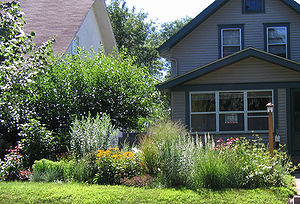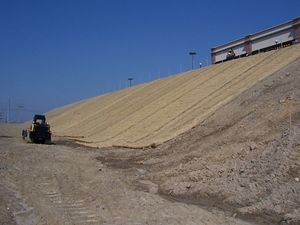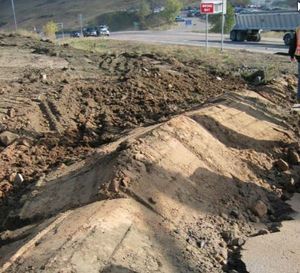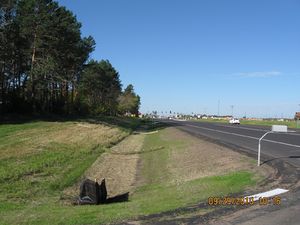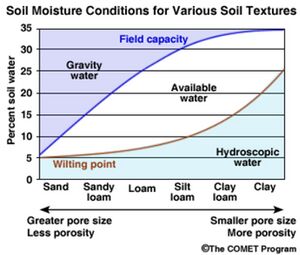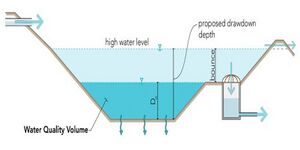
Operation and maintenance considerations for vegetation in stormwater management
This page provides a discussion of operation and maintenance (O&M) considerations when incorporating vegetation into stormwater practices.
Contents
- 1 Establishment periods (short vs. long term) and managing expectations
- 2 Creating a vegetation management plan for future maintenance
Establishment periods (short vs. long term) and managing expectations
Establishment Period refers to the time period immediately after installation, during which plants must be maintained to better ensure their success. The recommended time period varies depending on what is planted (seed, plugs, trees, etc.). The length of this period can also be affected by project goals and budgets. If a project is completed in phases, vegetative establishment may also incorporate phasing. Temporary covers can often provide interim stabilization between phases. It is critical to understand what maintenance is required during the Establishment Period. Specific considerations are unique to each site and should ask the following questions, at a minimum.
| Establishment period O&M considerations | |
| Item | Comment |
|---|---|
| Temporary cover crop | Vegetation, usually seeded, for protecting bare soil surfaces from erosion during the construction process and protecting seeded surfaces post-construction during the establishment of permanent vegetative cover. |
| Erosion and Sediment Control | Practices to prevent erosion or control sediment loss and protect the soil surface until cover has been established. |
| Irrigation | Water artificially delivered to vegetation to provide consistent plant-available soil moisture for the duration of the establishment period. |
| Off-line BMPs | Stormwater systems adjacent to the main stormwater system that indirectly receive stormwater runoff through diversion and that do not directly affect the functioning of the whole system. |
| Fencing | Fencing around vegetation to protect the vegetation from construction equipment and operations and/or from herbivory. |
- Which maintenance items are needed?: There are many types of maintenance that can occur for each vegetative type, but not all are necessary or appropriate within each project’s goals and budget. A landscape architect, restoration specialist, or other trained professional can assist with determining appropriate maintenance tasks by vegetation type. Careful determination of tasks and timing at the planning stage can result in an efficient scope, budget, and execution.
- How often should each maintenance item occur? Carefully evaluate the vegetation being established on the site, what the best practices for maintenance include, and how often those need to be included to establish a plan prior to installation. Some examples of considerations that would affect inspection and maintenance timing include seasonal rainfall, irrigation requirements, weeds and other vegetative pressures, heat and cold, aspect, and herbivory. The planned maintenance and maintenance staff should match the requirements of each vegetative type.
- Example: watering requirements for new trees can be in excess of 2 inches of water per week during the middle of the summer. Depending on timing, the required maintenance for irrigation alone may require multiple trips to a site each week and may require the use of a truck equipped with a water tank if irrigation water is not available on site.
- What is the schedule and timing of inspection and maintenance? What communication and reporting requirements are required? Maintenance timing again should be based on the type of vegetation being established and the site conditions. Consider how often maintenance should occur, as determined in the previous step, and create a plan and schedule for the maintenance at the planning stage. Typical maintenance periods are daily, weekly, monthly during the growing season, annually, or otherwise.
- Additionally, it is important to understand how reporting will need to occur and what personnel should perform the reporting. Standard forms or checklists are a beneficial tool to have for reporting inspection and maintenance. A communication plan is also helpful in determining which personnel, how often, what methods to use, and contact information for maintenance coordination throughout the project.
- What personnel are required to perform the maintenance? Do they have the necessary qualifications and equipment to perform the work? It is important to consider the type of maintenance required throughout the design of the project. Specially trained or certified personnel such as arborists, herbicide/pesticide applicators, and prescribed burn managers may be appropriate depending on the vegetation and project goals. These requirements should be considered in evaluating and hiring contractors to perform maintenance.
- What are the methods and benchmarks for evaluating success? What determines success varies by vegetation. For example, a successful sodded turfgrass area is very different from a successful native wetland planting. The time from installation to evaluation of success will vary as well by cover type. Proxy measures for evaluating success may be appropriate based on the evaluation period and timing.
- What are the costs? Consider the project budget when evaluating the duration of maintenance, short- and long-term goals (e.g., number of plants in a selected area, no bare areas, etc.), number of planned maintenance site visits, creating a maintenance plan, reporting, and other site-specific needs when determining the cost of the maintenance. Ensure the project budget considers maintenance. A line-item for maintenance in the contract can ensure successful execution of vegetative establishment.
The following are specific items to include in evaluating establishment maintenance needs and determining goals.
Temporary cover crop
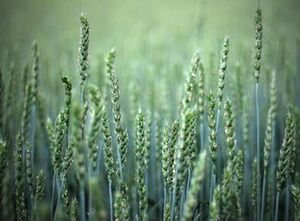
Temporary cover crops, or temporary covers, are vegetation established to provide temporary stabilization of sites and prevent erosion during the establishment period. This vegetation, usually seeded, has two main roles in stormwater management: a) protecting bare soil surfaces from erosion during the construction process, and b) protecting seeded surfaces post-construction during the establishment of permanent vegetative cover. Temporary cover establishes rapidly and the root structure provided firmly anchors the soil surface to prevent detachment and transport of sediment.
Both short- and long-term considerations in selecting cover crops should consider seed type, location/aspect, slope, duration of cover, and how the cover will be applied. These considerations should also incorporate any sediment and erosion control measures, regulatory requirements, and any Stormwater Pollution Prevention Plan (SWPPP) plan requirements. Selected cover crop must specifically address the season installed. Oats are appropriate for installation during the spring and summer. Winter wheat is appropriate for installation during the fall for winter cover. Mn/DOT Seeding Manual has specific seed mix and rates for your goals.
Cover crop needs to be reapplied every growing season. For example, cover seeded in the fall needs to be re-seeded in the spring on an active site or one that has not achieved final growth and cover requirements of final stabilization. Cover crop may need to be applied multiple times in phased projects.
Depending on the duration of time between project phases, a permanent cover may be required for temporary stabilization. Consider this approach when the project earthwork spans multiple years or where there is one or more dormant seasons between phases. Reference the Site Stabilization section for additional discussion on application of temporary and permanent covers.
Related Links:
- Bare soil cover types and percent reduction of soil loss
- Erosion prevention practices - temporary seeding and stabilization
- Native Vegetation Establishment and Enhancement Guidelines - Board of Soil and Water Resources (2019)
Developing strategies for erosion and sediment control during establishment
Erosion protection and sediment control strategies ensure continued stormwater protection for the duration of the project. Erosion prevention practices and sediment control practices combine to protect the soil surface until cover has been established. Careful consideration of the following practices should be weighed against the site constraints and management goals in protection of establishing vegetation.
- Focus on what best protects both the vegetation and soil surface during establishment. Vegetation may be permanent or temporary, depending on the stage of the project.
- Mulch is used to provide protection for establishing vegetation. The following are the most typical types of mulch used, by vegetation type.
- Shredded hardwood mulch. For use on trees, shrubs, and container-grown plants
- Do not use wood chips, as these are suspended and transported in stormwater
- Ensure no color dyes or other contaminants are present that may be leached and transported in stormwater
- Consider invasive species prevention (e.g., emerald ash borer) in selecting and importing mulch
- Straw mulch, loose. For use with temporary and permanent seeding
- Ensure Minnesota Crop Improvement Association (MCIA) or other independent certification of being noxious weed seed-free
- Do not use hay or other seeded mulch that may affect the composition and success of the intended seeded vegetation
- Not appropriate for use on slopes greater than 5% (1:20). Not appropriate for use in stormwater flow areas unless the device or BMP is offline during establishment.
- Refer to MNDOT Standard Specification for recommended requirements.
- Shredded hardwood mulch. For use on trees, shrubs, and container-grown plants
Mulch types application rates benefits, and limitations
Link to this table
| Mulch Type | Application Rate | Benefits | Limitations |
|---|---|---|---|
| Straw, hay, or other grasses | 1.5 to 2.5 tons per acre | Readily available and inexpensive; very effective in controlling erosion; can be applied on large sites via blower | Can carry unwanted seeds; might need tackifier or anchoring,
especially on steep slopes |
| Wood chips, bark, sawdust | 5 to 8 tons per acre | Very low cost in some locations; chips can be effective on slopes up to 30% | High nitrogen demand when decomposing; can float away or blow away during rain storms |
| Rock | 200 to 500 tons per acre | Could be inexpensive and readily available in some locales; might be suitable for smaller sites | Inhibits plant growth; adds no nutrients to the soil; can be costly to apply on slopes and large sites; adds hardened look to slopes |
| Hydraulically applied mulches | 1.5 to 2.5 tons per acre | Easily and rapidly applied with sprayer equipment; can include seed, fertilizer, flexible/fibrous mulches, and soil binders | Could be too expensive for small or very remote sites; after application, must dry for at least 24 hours before rainfall |
Types of mulch products typically used on construction sites
Link to this table
| Mulch type | Description | Application Method |
|---|---|---|
| Straw, hay, or other grasses | Wheat, oat, or pine straw; rolled or baled pasture grasses also used in some cases | Hand scattering for small areas; chopper/blower used for larger areas, sometimes with co-applied tackifying agent to promote adhesion |
| Wood chips, bark, sawdust | Waste product from sawmills and other timber harvest and processing operations | Hand scattering or mechanized spreader |
| Rock | Can include all classes of aggregate, riprap, and large stone; used for permanent erosion protection | Placement by hand or equipment (e.g., track-hoe, skidder, front-end loader) |
| Hydraulically applied mulches | Bonded fiber matrix products, including those manufactured with natural and/or synthetic fibers, cellulose, or other materials | Spray application via high-pressure pumping from the mixing tank, through a hose and nozzle apparatus |
- Erosion control blankets are used with temporary and permanent seeding and with plugging.
- Ensure MCIA or other independent certification of being noxious weed seed-free.
- Straw or coir+straw blankets are most commonly used in seeding areas. Straw, coir+straw, and coir blankets are often used in plugging and other planting areas.
- Erosion control blankets should be used for establishing vegetation in steeper (>5%) slopes, or where there is concern of stormwater runoff impacts to vegetation.
- Can be upgraded to TRM ( turf reinforcement mat) in high-flow, highly-erodible, or channel areas. Follow all manufacturers’ requirements in vegetation installation.
- Diversions.
- Diversions such as earthen berms, biodegradable coir logs (a.k.a. “bio logs”), or other temporary embankments can divert stormwater around establishing vegetation. This allows for better irrigation management and control during this period.
- NOTE: Fluctuation in inundation and soil moisture level is stressful for most plants during establishment. The plants are better able to tolerate and respond to storm events after firmly rooting in the adjacent soil.
- Silt fence
- Silt fence has a variety of uses. This can be used for sediment control, preventing sediment transported by stormwater onto establishing areas. This also can be used for exclusion fencing (see below).
- Ensure the silt fence is properly installed and maintained throughout the project. At the end of the project, silt fence must be completely removed and disposed of off-site after establishment period. Smooth out, repair, and establish permanent cover to address any disturbance caused by removal of silt fence.
- Grassed/Vegetated filter strips, ditch checks, and filter berms
- Grassed/vegetated filter strips, ditch checks, and filter berms address minimizing or preventing sediment-laden stormwater from entering vegetated areas.
- These can be temporary or permanent measures to assist in providing high water quality to establishing vegetation
- Address removing and repairing surfaces of any temporary measures at the end of the establishment period
All vegetation used for erosion and sediment control should consider the length and phasing of the project, as well as any necessary operations and maintenance before, during, and after the project. Multiple applications of temporary cover may be necessary to provide interim site stabilization throughout the progress of the project.
Temporary and permanent irrigation considerations
Irrigation is the primary requirement that most vegetative operations and maintenance plans must focus on. The goal is to provide consistent plant-available soil moisture for the duration of the establishment period. Water need not be potable but should be free of nutrients and pollutants. Initial irrigation requirements will be high but will lessen as the vegetation becomes established and well-rooted. Consider the following in establishing the operations and maintenance needs for irrigation.
- Irrigation systems
- There are many temporary and permanent irrigation systems available from a variety of manufacturers.
- It is important to select commercial-grade products for intended life and durability of commercial installations. Commercial or residential systems may be used for residential installations
- Controls and operations may be remote, automatic, or manual depending on the system and model selected. Water volume delivered, how water is applied, and how often should be a consideration to assist in operations and maintenance planning.
- A good rule of thumb is to assume irrigation should uniformly apply a minimum one inch (1”) of water per week over all vegetated areas. Newly sodded and turfgrass seeding areas can have significantly higher water demands during establishment and may require daily irrigation for the first 30 – 60 days. Match the irrigation system and irrigation volume to the vegetative water demands best support establishing vegetation.
- Commercial sites may consider an automated irrigation system with a controller and weather shut-off. These systems can provide supplemental irrigation during hot, dry seasons but shut off automatically when rain events have occurred. These can have significant up-front costs but significantly reduce the need and associated costs of long-term maintenance.
- Irrigation Delivery
- Irrigation system may deliver a spray, a stream, or drip. Spray and stream irrigation delivery is well-suited for large vegetation areas with fewer individual plantings. Drip irrigation is excellent for delivering water to individual plants or trees. Drip irrigation is very efficient when used as designed: it minimizes evaporative losses when in contact with the air by delivering water directly into the soil. Consider which type of irrigation best provides uniform coverage to root zones in selecting the best method of delivery.
- Permanent vs. temporary irrigation systems
- Temporary irrigation systems are installed just to support irrigation requirements during plant establishment and then removed. Example: temporary irrigation is provided to newly planted trees but removed upon establishment.
- Permanent irrigation systems are installed to provide ongoing irrigation support. These are most often installed in commercial sites with limited support of occasional irrigation requirements.
- Ideally, permanent irrigation systems use should be limited by selecting vegetation appropriate to the climate.
- Site-Available Water Sources
- Consider the water availability on the site and determine whether it is acceptable for use as irrigation.
- Hydrants, hose bibbs, and existing irrigation systems can provide sources for irrigation.
- Cisterns and temporary irrigation ponds can be created for temporary water collection and irrigation.
- Ensure any temporary irrigation system installed complies with local and state plumbing code and is coordinated with local officials and regulation requirements.
- Off-Site Water Sources will be necessary if no site-available water exists.
- Off-Site Water Sources
- Water tanker trucks or pump systems are often utilized for irrigation when no site-available water source exists.
- There can be significant costs to bringing water to the site from off-site locations.
- Trash pumps, or pumping from on-site water bodies can provide irrigation water when acceptable under regulatory requirements.
Offline BMPs during construction and plant establishment
BMPs can be categorized as online and offline. Online systems directly receive and control stormwater as part of a chain. Offline systems are adjacent to the main stormwater system, acting as a supplementary feature but do not directly affect the functioning of the whole system. When practicable, designing offline BMPs affords vegetation a significant advantage in establishing outside of fluctuating stormwater levels. One full growing season offline is recommended. Irrigation must be considered when establishing vegetation in offline BMPs. Operation and maintenance should include consideration for connecting features after establishment.
Temporary fencing
Temporary fencing serves two main functions in site vegetation establishment: (1) protecting vegetation from construction equipment and operations; and (2) protecting vegetation from herbivory. Temporary fencing can be categorized as tree (or vegetation) protection fencing, or animal exclusion fencing. Tree protection fencing is generally made of snow fence and metal t-stakes. This is to be installed as required to protect existing sensitive vegetation (usually trees) or new vegetation on the site. Operations and maintenance should consider when this is to be removed, generally at the end of the construction activities. Animal exclusion fencing is also generally composed of snow fence and/or silt fence and metal t-stakes. This also can incorporate a metal mesh such as hardware cloth when necessary for additional rodent protection. This is generally installed after vegetation has been installed but will remain in place for the duration of the establishment period after construction activities have been completed. Operations and maintenance should consider implementation and removal of animal exclusion fencing, as well as on-going inspection and repair to maintain an intact barrier. (Convert the following into a table?)
- Goose exclusion fencing often incorporates a double-row of 3-4 foot tall silt fence. This should be maintained for a full growing season before removal.
- Deer exclusion fencing is often a welded wire mesh 7 feet tall minimum. This should be maintained for a full growing season before removal or installed as a permanent feature if warranted by project goals.
- Beaver exclusion fencing is often 3-4 feet tall welded wire mesh or hardware cloth. Metal is required to prevent chewing. This should be maintained for a minimum of one year before removal or installed as a permanent protective feature (preferred).
- Other rodent protection fencing varies in height, but incorporates welded wire mesh or hardware cloth to prevent chewing. This should be maintained for a minimum of one year before removal or installed as a permanent protective feature (preferred).
- Permanent installation of fencing should consider gates in design for access and maintenance inside the fenced area.
Creating a vegetation management plan for future maintenance
Developing a vegetation management plan that addresses the identified operations and maintenance considerations is a critical item in a successful stormwater management project. Proper planning at the beginning of a project can save time and money over the life of the project. This section outlines some of the major considerations that need to be considered in developing restoration maintenance plan and considerations when designing stormwater BMPs.
Considerations for developing management plans
Typically, a vegetation management plan will include the following.
- Vegetation management goals
- Vegetation management schedule, including timeline for milestones, management activities, monitoring, and reporting
- Relevant management activities and strategies to be utilized in site development
- Reporting requirements, including points of contact, delivery method, any standard forms, frequency of reports, and any other reporting requirements
- Quality Assurance items, including contractor qualifications, copies of required certifications, site protection measures, and any performance requirements
Plant selection considerations
Vegetation management goals
In the process of selecting vegetation, think through and address goals you would like to achieve in short and long term management of the BMP vegetation or within the whole project. These goals can vary widely, based on a number of different drivers. For example, your plant selection and management goals may be affected by regulatory requirements, as in the case of projects funded by Clean Water Act allocations. Some funding sources may even necessitate vegetation management for a set number of years as part of their requirements. Defining clear goals will assist you in selecting appropriate plants for your project. They will also help you consider longer term maintenance needs and allow you to plan for the commitment (financial and physical) that it will take to reach your desired goals.
Some typical goals may include the following items
- Pollinator habitat creation
- Increasing stormwater detention compacity
- Filtration and water quality improvement
- Aesthetic improvements
- Stormwater planting demonstration area
- Low-impact development (LID) demonstration
- Sustainability demonstration
Active management
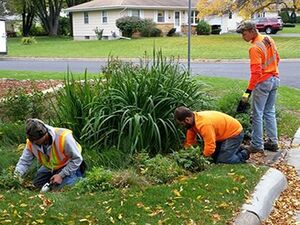
In selecting vegetation for your project, it is important to determine the type and amount of management that will be required according to the defined vegetative management goals. Some questions you may ask in defining active management include the following.
- Who will be providing maintenance?
- How often will maintenance be performed?
- What knowledge do they have of the plants that will be included in the design?
- Will they be able to tell invasive species or volunteer plants from the plant selected in the design?
- Will they have the correct equipment to actively maintain the design?
Ensure the Vegetation Management Plan addresses the active management requirements by pairing trained personnel and contractors to the site goals.
The following pages provide information on operation and maintenance of vegetated stormwater practices, including information on topics such as planting and seeding, inspection and maintenance cycles, time and equipment needed for O&M, and example maintenance agreements.
- Operation and maintenance of bioretention and other stormwater infiltration practices
- Operation and maintenance (O&M) of tree trenches and tree boxes
- Operation and maintenance (O&M) of green roofs
- Operation and maintenance (O&M) of swales
- Operation and maintenance (O&M) of filter strips
Site conditions and stressors
In the process of setting plant selection goals, you will also want to consider site context and stressors. These are additional factors that influence the plants you choose to incorporate into your design. Site context and stressors should focus on the conditions that could negatively impact the vegetation you have selected for the BMP design. Potential considerations include:
- Site hydrology
- Soil conditions
- Excessive nutrients or pollution
- Invasive species pressures
- Grazing from wildlife
- Disruption from human or animal activity.
Site hydrology
Before plant selection you should understand how much, how often, and how long the BMP is designed to hold water. Too much or too little water can have a drastic and significant impact on plant survival and maintenance needs. A Minimal Impact Design Standards (MIDS) best management practice (BMP) calculator was developed to assist designers and regulators in determining conformance to the MIDS performance goals. The MIDS BMP calculator is a tool used to determine stormwater runoff volume and pollutant reduction capabilities of various low impact development (LID) BMPs.
How much – bounce within BMP Water level will have a significant impact on the plant selection within the BMP. It is important to consider and select a plant that will be able to handle the hydraulic conditions in which it is planted. Before selecting a plant, you will want to know the location of the highwater or inundation level within your BMP and the potential water level fluctuations (bounce) within a bmp. This will help you select plants that can either tolerate periods of time with inundated roots or plants that cannot. Other questions that might be helpful to ask when reviewing plant material for your BMP include the following.
- How much water is the BMP designed to hold and where is that high-water line located within the BMP design?
- Where will a high-water level (what elevation) be in a typical rain event?
- Where will a high-water level (what elevation) be in a large rain event?
- What type or types of rain events is your BMP designed for (5yr, 10yr, or 100yr event)?
- What types of vegetation will thrive below and/or above the different high-water lines?
How long – length of inundation In addition to understanding the highwater or inundation level of your BMP you will also want to understand the length of inundation. Length of inundation, or the given time in which your BMP is at a high-water level, will help you best determine what types of plants will best be suited to thrive within your BMP. It will also help you determine the successful locations for plants with regard to their ability to tolerate longer periods of inundation. Other questions that might be helpful to ask when reviewing plant material for your BMP include the following.
- How long will it take for water to infiltrate or pass through your designed BMP?
- What type of storm event (5yr, 10yr, or 100yr recurrence interval) is the BMP designed for?
- What plants can handle long periods of inundation and what plants can only handle short periods of inundation?
- What is the period of inundation in different locations within the BMP design?
How often - duration between rain events Finally, it is important to understand how often rain events occur that will raise the water level of your BMP to a high-water level elevation. This will help narrow the choice of plant selection and help determine plant varieties that are best suited for to the BMP design. Questions that might be helpful to ask when reviewing plant material for your BMP include the following.
- How often does a given rain event occur?
- What type or types of storm event (5-year, 10-year, 100-year, or other recurrence interval)? How much time is estimated between rain events?
- What types of plants will thrive within the given inundation period and an estimated duration between the next inundation period?
Soil conditions
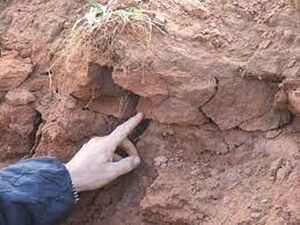
Soils affect stormwater and stormwater management in two ways.
- Soil is a source of sediment and associated pollutants (e.g. metals, organic compounds) for stormwater runoff
- Soil affects the types of stormwater management practices, such as vegetation or infiltration, that can be implemented at a site
The types of stormwater practices that can be implemented at a site are largely determined by soil conditions. Of particular importance are soil suitability for infiltration, suitability for implementing vegetated practices, and suitability for retaining pollutants. Understanding the type of soil on your BMP can help you to select plant material that will be best suited for your site.
Below are useful links to additional information on soil and effects of soil on vegetation. To learn more about how soil can impact the vegetation on your site the overview and role of soil in stormwater management at the link below.
- Overview and role of soil in stormwater management
- general information on soil and BMP design
- Understanding of soil bulk density and root growth based on soil texture
- Submit a soil test at the University of Minnesota
Excessive nutrients and pollutants
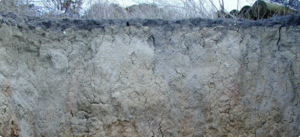
In the process of plant selection, you will want to consider the location of your BMP and the potential for excessive pollutants or nutrients to enter and potentially physically harm the vegetation in your design. Considerations include salt, sediment, trash.
Salt Sodium chloride is widely used as a deicer in cold climates. Both sodium and chloride can negatively impact vegetation.
Vegetation can be negatively impacted by absorption of chloride through the plant roots, or from accumulating on the foliage and branches. The symptoms associated with salt impacts are similar to those of a drought; stunted growth, brown and falling leaves/needles, dying limbs, and premature plant depths (National Research Council, 1991). An estimated 365,000 tons of road salt is applied in the Twin Cities Metropolitan Area (TCMA) each year. The chloride in road salt flows into our lakes, streams, and groundwater, potentially harming our environment. Therefore, it is an important consideration when selecting plant material for a BMP.
Another consideration is the location of your BMP. How close are you to a source of chloride pollution? The effect of chloride on plants has been seen at distances of 100 to 650 feet off the road (Fischel, 2001). The level of chloride that must be reached before the plant is harmed depends on the type of vegetation. It may be helpful to consider salt tolerant plants depending upon the location and pollution loads expected in the BMP. (table regarding placement of BMP as it relates to salting, best practices?)
The following links may be useful.
Sediment Sediment is composed of loose particles of sand, clay, silt, and other substances. It comes from eroding soil and runoff. Sediment contributes to turbidity — cloudy water that is harmful to fish and plant life — and, in large quantities, can fill in bodies of water. Sediment may also be contaminated by pollutants, particularly phosphorus.
Factors to consider include the following.
- Purpose or function of the bmp. Some bmps are designed to capture sediment, such as sediment traps and basins.
- Sediment load. Sediment loads vary with land use, time of year, length of time between rain/runoff events, watershed characteristics, and rainfall characteristics. For more information on factors affecting sediment loads, link here.
- Required bmp maintenance. Some bmps, such as bioretention, require regular maintenance to function properly, while other bmps such as constructed ponds accumulate sediment over a long period of time. Certain plant species may be sensitive to sediment accumulation or to pollutants associated with sediments.
Trash Stormwater runoff has the potential to transport large quantities of trash to stormwater bmps. Trash in stormwater varies from smaller items such as cigarette butts to larger items such as plastic. The quantity and characteristics of trash in runoff vary with the source area. Trash can interfere with bmp function, primarily by clogging bmp inlets and outlets, can impede vegetation growth directly (physically), or can carry pollutants harmful to vegetation. Trash can be controlled through proper pretreatment and through bmp[ maintenance.
Invasive Species Pressures
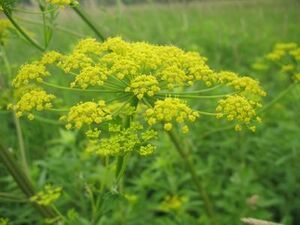
In the process of plant selection, you will want to consider the location of your BMP for the potential for invasive species pressure. Invasive species can make long-term maintenance a challenge. Not only can it require more physical work it may also be challenging for maintenance crews to distinguish between invasive and native plants. When considering planting of your BMP it is important to understand the likelihood that you will be dealing with invasive species in your design. (Convert the following into a table?)
Invasive Seed bank In the design process it is important to note the existing vegetation in the location of your BMP. What plant currently live in and around the area? Seeds can lie dormant in soil for extended periods of time and create maintenance challenges if not properly thought through in the initial stages of a project.
Site Adjacency Invasive species can easily be transfer from one site to another, especially through water systems. Taking note of surrounding vegetation communities when selecting plants can help you design for easier long-term maintenance.
Maintenance In the process of plant selection and considering invasive species it is important to understand the client, owner, or caretakers’ ability to maintain for invasive species. If there is little to no maintenance planned for a project that has a high likelihood of invasive species pressure it might be useful to select plants that can compete with invading species. If you have a dedicated maintenance staff, you can start to learn to identify invasive species at the links below. Depending upon the BMP project, location, and likelihood of invasive maintenance required it may also be helpful to consult with a professional.
Learn more about identifying invasive species at the following links
- Invasive terrestrial plants - Minnesota Department of Natural Resources
- State prohibited noxious weeds - Minnesota Department of Health
- Identify invasive and non-native species - University of Minnesota
- Invasive plants - Board of Water and Soil Resources
Human and animal disruption
When considering plant selection for long-term maintenance it is worth considering what types of human and herbivory pressure may be found at your site. Considerations may include the following.
Site location Is it located within an a heavily trafficked area (humans or animals)?
- Is your BMP located within an urban core?
- Will you have concern about off leash dogs running through the site disrupting vegetation or compacting soil?
- Will you have concern about humans walking through disrupting vegetation or compacting soil?
- Is your BMP located next to or within a natural area (nature preserve, park, or open space)?When considering plant selection for long-term maintenance it is worth considering what herbivory pressure is found at your site. Will you have concerns regarding browsing from deer or other herbivores?
Vegetation growth consideration
BMP Design Function and Infrastructural Considerations. In consideration of plant material, you will want to investigate the infrastructural needs and design of your BMP. Placing a tree directly next to a stormwater catch basin would be a cause for future maintenance issues. Placement and vegetative growth of a selected plant should be taken into consideration in BMP design. Additionally, plant selection, placement, and growth should be taken into consideration when thinking about management activity and access needs to maintain the stormwater infrastructure. Questions to consider include the following.
- Are there existing utilities and where are they located?
- What are the maintenance needs of the BMP?
- Will there need to be access into the BMP (specifically to certain infrastructural components)?
- What kind of access will be needed (truck, skid steer, or excavator)?
- Where is access located and how will it interact with the plant selection in the design?
- Are there future needs (infrastructural or utility focused) that may need to be accommodated or considered in your planting design?
Changing Vegetation Microclimates. When considering long-term planting success, you will want to consider the growth and life cycle of the plant material selected in your design. For example, a tree may be an excellent choice as a part of a BMP design but over time and with growth of the tree, it may easily shade plant material within the BMP. They shade from the tree could become a maintenance issue if other plant material was selected for full sun conditions. Actively planning for the growth and succession of plant material will strengthen the long-term maintenance success of the design and function of the BMP. Questions to consider include the following.
- How will the plants you selected in your design change over time?
- Will there be a need to change plant selection in due to plant growth in the future?
- Are there outside forces that might impact the growth or plant communities over time?
Costs as relates to establishment and long-term maintenance
Vegetation costs and replacement of plants In the process of plant selection consideration should be taken over the lifecycle of the plant selected.
- How long will the plant live?
- What shape does a mature form of the plant take (size and form)?
- How long will it take to reach maturity and how will your design (BMP) function as the plants grow?
- How does the plant propagate (can a plant spread through rhizomes)?
- How successful is it at propagating?
In the process of investigating these questions a designer will be able to determine if the owner, client, or caretaker should prepare to replace a plant within a given time frame or if they will need to perform maintenance tasks to prevent the plant from spreading and taking over a given area.
Pruning of plants Pruning vegetation can be a helpful tool in long-term maintenance and can also be a consideration when selecting plant material. Pruning can act as a preventative measure for both insect and disease damage, maintain an intended purpose for specific plants in a landscape, and approve appearance of plants.
When selecting vegetation, it will be helpful to consider the goals and needs of the project. Pruning can be an effective tool for trees and shrubs, and you will want to understand your specific project needs when considering plant material choices. Depending upon project specifics pruning may be a requirement. Pruning is also a maintenance task that will take place over multiple years and require some education for individuals performing the task. You will want to take these considerations into account when selecting types and quantities of plant material.
For more information link here
Removal of trash and sediment All landscape areas should remain as litter free as practicable. Understandable, some landscapes are designed to collect trash and allow it to be removed from landscapes. Determine the needs in your BMP to collect and remove trash that may build up overtime. When selecting plant material be aware of trash, debris, sediment, and other removal needs and how it may impact your planting choices and locations.
Additional plantings or species succession
Irrigation
Resilient designs
A resilient planting design is a design that can withstand or recover from changing circumstances. When thinking about plant selection it is important consider serval aspects of a resilient design to ensure the continued success of a BMP design and function. When considering a resilient design, it is important to consider the climate change, pests and disease, and your maintenance needs on a project.
Climate change (plants that will adapt) Our climate is changing due to human impacts on the environment. Increased heat, drought, larger rain events, and changing winter conditions are all associated changes taking place with climate change. Planning for these changes within your plant selections will help reduce the amount and expense of maintenance needed on a project.
- Learn more about climate change here: What Is Climate Change? | United Nations or at NASA: Climate Change and Global Warming
Heat
- What are the projected temperature changes in the location of your BMP design?
- What are the microsite conditions of your site (will you get lots of sun or will it permanently be shaded)?
- What plants might be able to adapt to changing conditions or your microsite conditions?
- Are you located within an urban area with large amounts of impervious surface?
Drought
- What water requirements are needed for the plants selected in the BMP design?
- With increased duration between rainfall events, will the selected plants be able to survive without routine rainfall?
- Will the selected plants require supplemental irrigation? For how long (through establishment or continued throughout the lifecycle)?
Larger rain events
- Will the plants selected be able to withstand larger rain events?
- Will the plants selected be able to handle longer inundation periods?
- What additional maintenance concerns might increase flow or hydraulic movement through your design cause? Will your plants selected be able to withstand increase flow rates?
Warmer winters
- What is the lifecycle of your selected plant?
- Does it require a certain freeze or prolonged cold period? Will it be able to thrive in a warmer winter condition?
Pest and disease When selecting plant material, it is important to understand and consider what pests and diseases are associated with potential plant choices. Selection of a plant that has a known pest or disease moving through a given geographical area increase the risk and cost of future maintenance and or replacement of a given plant. It is important to understand the known pests and diseases that might have an impact in your site and given location. In a similar fashion, a planting design without diversity is more susceptible to pest and disease. Although a monoculture design may be easy to maintain it is also at a higher risk for concern if there is an associated health or climate adjustment that creates a problem for the given plant. Therefore, it is important to design with a diversity of plants and species to allow for a greater resistance to future health and climate changes.
Learn more about tree health, disease, and pests in Minnesota at the links below.
- Tree care diseases and pests: Minnesota DNR
- Insects / Arthropods of Minnesota: Minnesota DNR
Design to maintain Design for budget Planning for a maintenance budget is a key part of a resilient design. Long-term maintenance can be expensive and challenging to sustain but is also crucial for a successful project. When selecting plant species, it is important to consider the funds and resources available to the owner, client, or caretaker to continually maintain the design. (To include high level planning cost consideration table?)
- What funds are available to the client, owner, or caretaker?
- What level of maintenance will the client, owner, or caretaker be able to provide?
- How much work will a planting design or specific plant material take to maintain?
- How often will someone be required to perform routine or essential maintenance on chosen plant material?
- Can the plant material and design function without maintenance?
Bandwidth to maintain In line with designing for resilient budget it is important to design for the range of knowledge, time, and energy a maintenance crew will be able to provide on a specific site. Designing within a maintenance crews Bandwidth will allow for the continued success of a project. Considerations when selecting plant include the following.
- How much plant knowledge, background, and interests does your maintenance crew have?
- Will they have the plant identification knowledge to distinguish between an invading or an invasive plant and a selected plant in the BMP design?
- Will they have the interest to learn specific maintenance tasks (e.g., how to prune a tree or shrub) to maintain a plant species?
- Will they have the time to learn specific maintenance tasks (e.g., how to prune a tree or shrub) to maintain a plant species?
- What is the size of your project and how many maintenance staff will you have to preform required maintenance tasks?
- It is possible to have a knowledgeable staff but not have enough staff to perform the required maintenance tasks.
- How often will the maintenance staff be available to preform required tasks?
